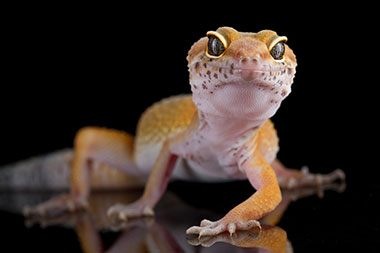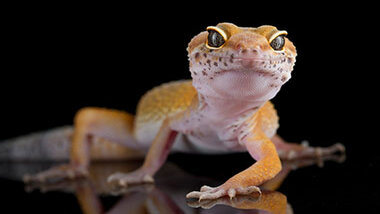If you are beginning your journey into herpetology, you can avoid being a part of this problem and ensure your reptile will have a long and happy life with you by choosing a species that is appropriate for new owners.
So what kind of reptile is the easiest to take care of if you’ve never done it before? Look no further than the leopard gecko!These lizards are known for their beautiful pattern that resembles a leopard print and for their gentle and docile personalities.
Read on to learn six reasons why leopard geckos are the best lizard for beginner reptile-keepers!

-
Easy Maintenance
Forget about frozen mice or trying to feed your reptile live prey—the leopard gecko thrives on insects alone, making their dietary needs relatively simple and inexpensive.
Their preferred insects include crickets, mealworms, wax worms, and superworms, all of which can be purchased at any pet store.
Babies and juveniles require feeding every other day, and adults will need to be fed only about three times per week.
They will also need a calcium/vitamin D3 supplement, which comes in a powder and can be dusted on the insects before feeding them to your gecko.
Leopard geckos, like all reptiles, should have constant access to fresh, clean water.
-
Friendly Temperament
Leopard geckos are known for being friendly and docile, meaning they rarely bite.
These reptiles love to climb and explore, and will love to climb up your arm if you let them!
So long as you are gentle, they will have no problem socializing and being handled. However, watch out for signs of stress in your gecko, which include hissing and tail waving.
Leopard geckos have autonomy, which means that they can detach their tails from their bodies as a response to feeling threatened.
-
Moderate Enclosures
Leopard geckos only require a 10-20 gallon tank, and up to 3 lizards can live together in the same enclosure, provided there is only one male. If you are housing more than one gecko together, go for a tank on the larger end.
Unlike other reptile species who may quickly outgrow their enclosure, leopard geckos can stay in the same tank throughout their lifespan. They only grow between 7 and 10 inches long and can live 15-20 years, provided they are appropriately taken care of.
These reptiles are nocturnal, meaning they do not require as much UV/UVB light as diurnal species.
However, they still require an artificial heat and light source for their tank. Like all reptiles kept in captivity, they need a heat gradient in their tank, which can be easily achieved with a well-placed basking bulb.
-
Low Price
On average, a leopard gecko costs about $30 from a pet store. This makes leopard geckos one of the least expensive reptiles, and perfect for someone without the financial resources to dedicate to a larger or rarer species.
Some of the less common leopard gecko morphs can cost up to $200, but normal geckos both come in at a budget-friendly price tag.
After the initial costs of the animal, enclosure, heat and light, and cleaning supplies, the long-term investment is much lower than other pets like dogs and cats.
-
Easy Cleaning Requirements
Because they are on the smaller side for reptiles, this means that their messes are also smaller!
Reptile carpet, paper towels, and newspapers can all be used as substrate in the tank.
Carpet will need to be spot-cleaned daily, and paper substrate should be replaced weekly.
The enclosure should be deep-cleaned on a monthly basis, which will require removing your lizard, substrate, and any décor (such as stones, branches, and hideout caves) and using a water/bleach solution to sanitize the tank.
-
Good For The Whole Family
Their easy-going temperament means they can get along with your entire family, including pets you may already have.
They are happy to be picked up and handled, and they do well with young children.
Involving children in the care of a family pet can be a great way to teach them responsibility, empathy, and social skills. Just be sure that if your child is handling your leopard gecko, they are mature enough and have enough manual dexterity so as not to squish the lizard.
Their tank may be placed on a higher surface or desk, making it easy for the elderly or anyone with mobility issues to access animal and play a role in its care.
With the proper planning, it is even possible to introduce a leopard gecko to your current pets (even dogs and cats) and foster a friendship between the two species.
Summary
Their low cost, simply husbandry and maintenance requirements and their docile, family-friendly personalities make them a great choice for any beginner herpetologist.
Tell us about your experience raising a leopard gecko in the comments section!




